Vinyl vs. Laminate Flooring: What's Right for Your Room
When it comes to choosing the perfect flooring for your home, you want a balance of style, durability, and affordability. Two popular options that often come up in the search for the ideal flooring are vinyl and laminate. While both offer a range of benefits, understanding their differences and similarities is essential in making an informed decision.
Here we delve into the world of vinyl vs. laminate flooring, exploring their features, pros and cons, installation processes, maintenance requirements, and more. By the end, you'll have a comprehensive understanding of these flooring options, empowering you to choose the best one for your specific needs.

Understanding Vinyl Flooring
What is Vinyl Flooring?
Vinyl flooring is a synthetic flooring option made primarily from PVC (polyvinyl chloride) and other additives. It is known for its versatility, as it can mimic the appearance of various materials such as hardwood, stone, or ceramic tiles. Vinyl flooring comes in different forms, including sheets, tiles, or planks.
Types of Vinyl Flooring
There are two main types of vinyl flooring: sheet vinyl and luxury vinyl. Sheet vinyl is a continuous roll of flooring material that is typically installed in large, seamless pieces. Luxury vinyl, on the other hand, comes in individual pieces, resembling planks or tiles. Luxury vinyl is often preferred for its enhanced durability and realistic visuals.
Benefits of Vinyl Flooring
Vinyl flooring offers several advantages that make it a popular choice among homeowners:
- Affordability: Vinyl flooring is generally more budget-friendly compared to other flooring options, such as hardwood or natural stone.
- Durability: Vinyl is resistant to scratches, stains, and dents, making it a suitable choice for high-traffic areas in the home.
- Water Resistance: Vinyl flooring is highly water-resistant, making it an ideal option for areas prone to moisture, such as kitchens and bathrooms.
- Low Maintenance: Vinyl is easy to clean and requires minimal maintenance. Regular sweeping and occasional mopping are usually sufficient to keep it looking pristine.
- Comfort Underfoot: Vinyl flooring offers a cushioned and comfortable surface to walk on, reducing the impact on joints and providing a more pleasant experience.
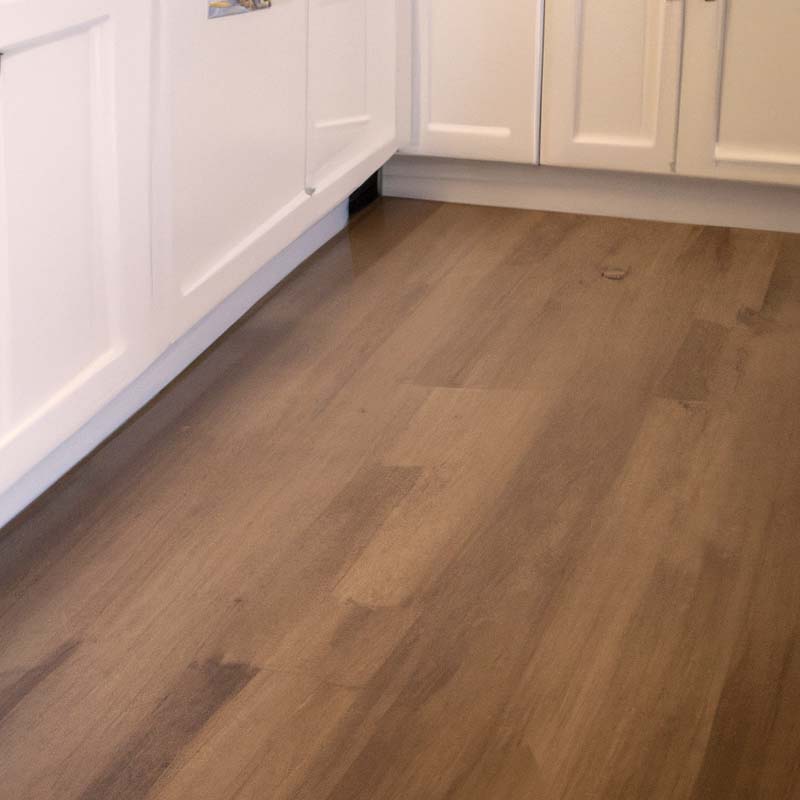
Exploring Laminate Flooring
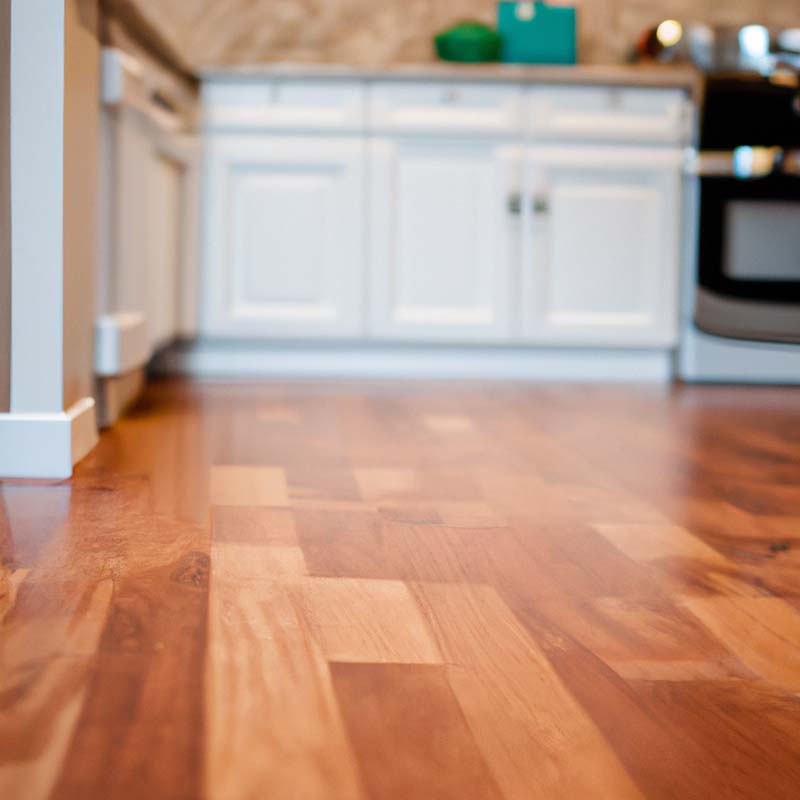
What is Laminate Flooring?
Laminate flooring is a composite material constructed with multiple layers. It typically consists of a fiberboard core topped with a high-resolution image of wood or other materials, protected by a wear layer. Laminate flooring can closely resemble the look of hardwood, stone, or tile.
Types of Laminate Flooring
Laminate flooring is available in various styles and formats, including plank and tile designs. It often features a click-lock system that allows for easy installation without the need for adhesives.
Advantages of Laminate Flooring
Laminate flooring offers several benefits that make it an attractive choice for homeowners:
- Realistic Appearance: Laminate flooring captures the natural look and texture of wood or other materials, providing a visually appealing and authentic aesthetic.
- Affordability: Laminate flooring is generally more cost-effective than hardwood or stone flooring, making it a popular choice for budget-conscious homeowners.
- Durability: Laminate is highly resistant to scratches, fading, and stains, ensuring long-lasting beauty and performance.
- Easy Installation: Many laminate flooring options feature a click-lock installation system, making it a suitable choice for DIY enthusiasts.
- Low Maintenance: Laminate flooring is easy to clean and maintain, typically requiring regular sweeping and occasional damp mopping.
Durability and Longevity
Vinyl Flooring Durability
Vinyl flooring is known for its durability and ability to withstand daily wear and tear. Its resistance to scratches, stains, and moisture makes it an excellent choice for households with children and pets. However, excessive exposure to direct sunlight can cause fading or discoloration over time.
Laminate Flooring Durability
Laminate flooring is also highly durable and can withstand heavy foot traffic. Its wear layer provides protection against scratches and stains, ensuring the floor's longevity. However, laminate flooring can be more susceptible to moisture damage compared to vinyl, and excessive water exposure should be avoided.
Comparing Lifespan
Both vinyl and laminate flooring can have a lifespan of 15 to 20 years or more with proper care and maintenance. The actual lifespan depends on factors such as product quality, installation, maintenance practices, and the level of foot traffic in the area.
Design and Aesthetics
Vinyl Flooring Designs
Vinyl flooring offers a wide range of design options to suit various styles and preferences. It can faithfully replicate the look of hardwood, stone, or tile, providing an affordable alternative to natural materials. With advancements in technology, vinyl flooring now features realistic textures and embossed finishes, enhancing the overall visual appeal.
Laminate Flooring Aesthetics
Laminate flooring excels in providing realistic wood or tile visuals. The high-resolution images used in laminate flooring production capture the natural characteristics, such as grain patterns and knots, of different wood species. Some laminate options even come with embossed textures, further mimicking the feel of genuine hardwood.
Choosing the Right Style
When selecting between vinyl and laminate flooring, consider the desired aesthetic for your space. Vinyl offers a broad spectrum of design choices, allowing you to achieve the desired look with ease. Laminate, on the other hand, shines in replicating the warmth and beauty of hardwood floors. Consider the existing decor and overall theme of your home to determine which flooring option will complement it best.
Carpet Guys Offerings

Western Row by
Mohawk

Western Row by
Mohawk

Ultra Transom by
Mohawk
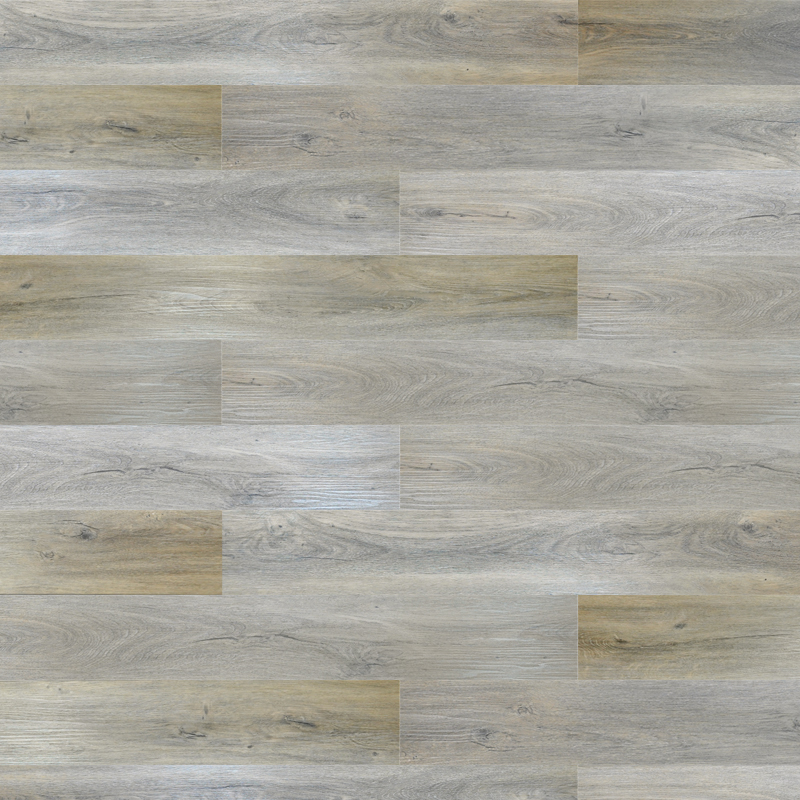
Stone Elegance by
Happy Feet
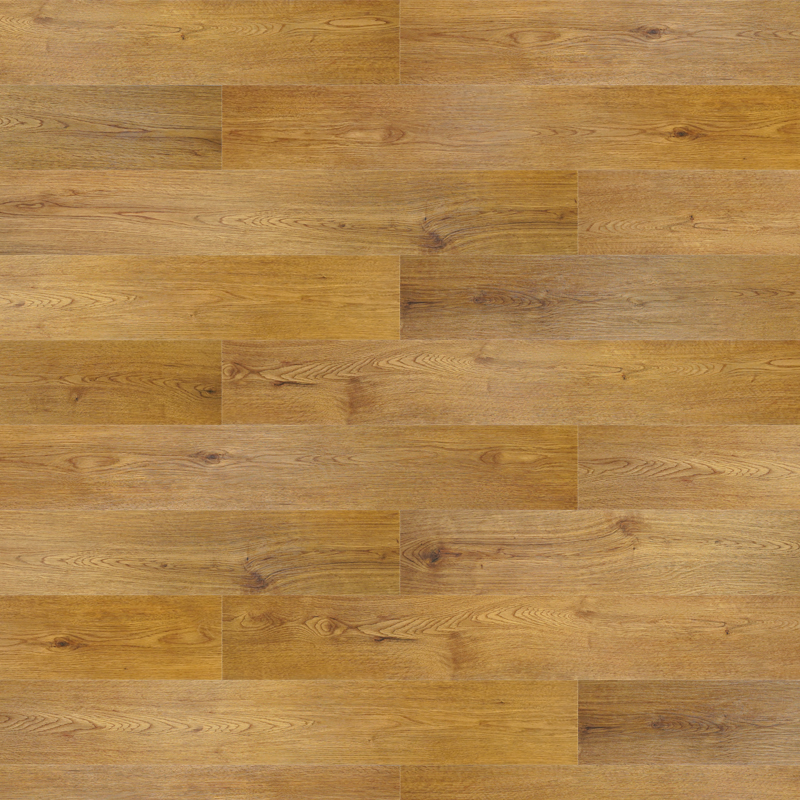
Mustang by
Happy Feet
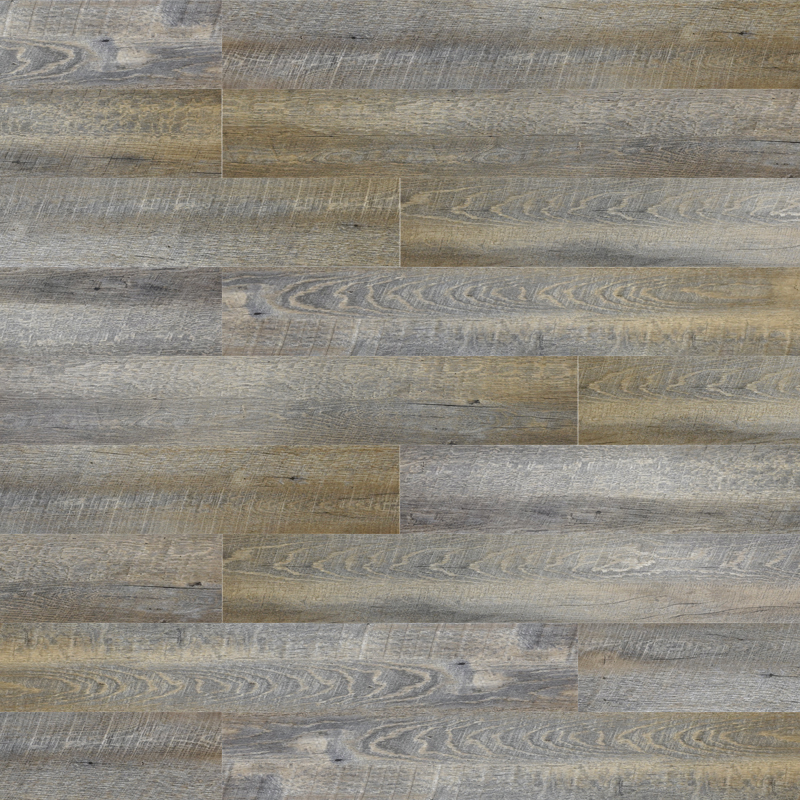
Mustang by
Happy Feet
Installation Process
Vinyl Flooring Installation
Vinyl flooring can be installed in several ways, depending on the product type and personal preference.
- Peel-and-Stick: Some vinyl flooring options come with a self-adhesive backing, simplifying the installation process. Simply peel off the protective layer and stick the planks or tiles onto a clean and prepared subfloor.
- Loose Lay: Certain vinyl products are designed to be loose laid, meaning they can be installed without adhesives or nails. The planks or tiles have a backing that provides grip and stability.
- Glue-Down: This installation method involves using adhesive to secure the vinyl flooring to the subfloor. It provides a more permanent and secure bond, especially in high-traffic areas.
Laminate Flooring Installation
Laminate flooring installation typically involves a floating floor method, which means the planks or tiles are not directly attached to the subfloor.
- Underlayment: Before installing laminate flooring, it's common to lay down an underlayment. This layer helps with sound reduction, moisture protection, and providing a smooth surface for the flooring.
- Interlocking Planks: Laminate flooring planks or tiles often feature a click-lock system, allowing them to fit together seamlessly. This makes installation relatively straightforward, as the planks are connected by simply snapping them into place.
- Expansion Gaps: It's important to leave a small expansion gap between the flooring and the walls or other fixed objects. This allows for natural expansion and contraction of the laminate due to temperature and humidity changes.
Considering DIY or Professional Installation
Both vinyl and laminate flooring can be installed as a DIY project, especially with the availability of user-friendly installation methods. However, if you're unsure about your skills or have a complex installation scenario, it's advisable to seek professional assistance. Professional installers have the expertise and tools to ensure a flawless and efficient installation, saving you time and potential headaches.
Maintenance and Care
Cleaning Vinyl Flooring
Vinyl flooring is low-maintenance and requires simple cleaning routines to keep it looking its best:
- Regular Sweeping: Use a soft-bristle broom or a vacuum cleaner with a non-abrasive attachment to remove loose dirt and debris from the floor.
- Damp Mopping: For deeper cleaning, a damp mop with a mild vinyl floor cleaner can be used. Avoid excessive water and harsh cleaning chemicals, as they can damage the flooring.
- Spot Cleaning: Promptly clean up spills and stains to prevent them from setting. Use a damp cloth or mop with a mild cleaning solution suitable for vinyl flooring.
Caring for Laminate Flooring
Laminate flooring is also relatively easy to maintain, requiring the following care practices:
- Regular Sweeping or Vacuuming: Remove loose dirt and dust particles using a soft-bristle broom or a vacuum cleaner with a brush attachment.
- Damp Mopping: Periodically mop the laminate floor using a well-wrung mop or a microfiber cloth dampened with a mild cleaning solution specifically formulated for laminate flooring.
- Avoid Excess Water: Excessive moisture can damage laminate flooring. Wipe up spills immediately and avoid wet mopping or using excessive water during cleaning.
Protecting and Preserving Your Investment
To maintain the beauty and longevity of both vinyl and laminate flooring, consider the following tips:
- Use Protective Pads: Place felt or rubber pads under furniture legs to prevent scratches and indentations.
- Avoid Harsh Chemicals: Use cleaning products that are specifically recommended for vinyl or laminate flooring. Harsh chemicals and abrasive cleaners can cause damage.
- Protect from Sunlight: Use curtains or blinds to minimize direct sunlight exposure, as it can cause fading or discoloration over time.
- Manage Moisture: Wipe up spills promptly and avoid excessive moisture on the flooring surface. Use mats or rugs in high-traffic areas or near entryways to collect dirt and moisture.
Pricing and Affordability
Vinyl Flooring Costs
Vinyl flooring is generally more affordable than hardwood, natural stone, or ceramic tile. The overall cost depends on several factors, including the quality and thickness of the vinyl, the installation method chosen, and any additional features or customization. On average, vinyl flooring can range from $2 to $8 per square foot, including installation.
Laminate Flooring Prices
Laminate flooring is also known for its cost-effectiveness compared to hardwood or stone flooring options. The price of laminate flooring is influenced by factors such as the quality, design, thickness, and brand. On average, laminate flooring can cost between $3 and $10 per square foot, including installation.
Evaluating Long-Term Value
When considering the cost of vinyl or laminate flooring, it's essential to assess the long-term value it offers. While both options are generally more budget-friendly upfront, they also provide durability and longevity, reducing the need for frequent replacements. Additionally, their low maintenance requirements can save you time and money in the long run.
Environmental Considerations
Sustainability of Vinyl Flooring
Vinyl flooring has faced some criticism regarding its environmental impact. It is a synthetic material derived from petroleum, and the production process involves energy-intensive manufacturing. Additionally, certain types of vinyl flooring may contain phthalates, which are chemicals of concern in some applications.
Eco-Friendly Aspects of Laminate Flooring
Laminate flooring, especially those with industry certifications like the Forest Stewardship Council (FSC), can offer more environmentally friendly options. Many laminate products are made from sustainable wood sources, such as high-density fiberboard (HDF), which uses recycled wood fibers. Laminate flooring also does not require the harvesting of old-growth trees for production.
Making an Environmentally Conscious Choice
If environmental sustainability is a priority, it's important to consider the eco-friendly aspects of vinyl and laminate flooring. Look for vinyl flooring products labeled as phthalate-free and those with low volatile organic compound (VOC) emissions. Similarly, choose laminate flooring that has certifications for sustainability, such as FSC certification or Indoor Air Quality (IAQ) certification.
Comparison Chart: Vinyl vs. Laminate Flooring
| Features | Vinyl Flooring | Laminate Flooring |
|---|---|---|
| Look and Aesthetics | Can replicate various materials; wide design options | Realistic wood or tile visuals; captures natural characteristics |
| Affordability | Generally more budget-friendly | Cost-effective alternative to hardwood or stone |
| Durability | Resistant to scratches, stains, and moisture | Highly durable and can withstand heavy foot traffic |
| Installation | Various installation methods available | Floating floor installation with click-lock system |
| Maintenance | Easy to clean and low maintenance | Simple care routine; avoid excessive water |
| Pricing | Typically ranges from $2 to $8 per square foot | Generally ranges from $3 to $10 per square foot |
| Environmental Impact | Synthetic material; may contain phthalates | Sustainable options available; some products use recycled materials |
Factors to Consider for Your Specific Needs
When deciding between vinyl and laminate flooring, consider the following factors based on your specific needs:
Budget and Affordability: Evaluate your budget and determine which flooring option aligns with your financial constraints.
Foot Traffic and Usage: Consider the level of foot traffic in the area where the flooring will be installed. Vinyl and laminate both offer durability, but some products may be better suited for high-traffic areas.
Aesthetics and Design: Determine the desired look and feel you want to achieve. Explore the design options and styles available in vinyl and laminate flooring to find the best match for your aesthetic preferences.
Moisture and Water Exposure: Assess the potential exposure to moisture in the installation area. If moisture is a concern, consider the water-resistant properties of vinyl or the need for additional precautions with laminate.
Installation Method: Evaluate the complexity of the installation process and decide whether you prefer a DIY-friendly option or if you'll hire professional installers.
Environmental Impact: If environmental sustainability is important to you, explore the eco-friendly aspects and certifications of vinyl and laminate flooring options.
By considering these factors, you can make an informed decision and choose the flooring option that best suits your needs, budget, and personal preferences.
Conclusion
In the battle of vinyl vs. laminate flooring, both options offer their unique advantages and considerations. Vinyl flooring provides exceptional water resistance, ease of maintenance, and a wide range of design choices. On the other hand, laminate flooring stands out with its realistic wood or tile visuals, affordability, and durability.
When choosing between vinyl and laminate flooring, assess factors such as your budget, desired aesthetic, durability requirements, installation preferences, and environmental considerations. By doing so, you can select the flooring option that aligns with your needs and provides long-lasting beauty and functionality for your space.
FAQs (Frequently Asked Questions)
1. Can vinyl flooring be installed in bathrooms or other high-moisture areas?
Yes, vinyl flooring is an excellent choice for areas with high moisture, such as bathrooms and kitchens. Its water-resistant properties make it suitable for these spaces, but it's essential to ensure proper installation and sealing of seams and edges to prevent water penetration.
2. Can laminate flooring be installed in basements?
Laminate flooring can be installed in basements, but it's crucial to consider the moisture levels in the specific basement. Since basements tend to have higher humidity and moisture, it's advisable to choose laminate flooring with moisture-resistant features and install a vapor barrier or underlayment to protect against moisture.
3. Can vinyl or laminate flooring be installed over existing flooring?
Yes, in many cases, vinyl or laminate flooring can be installed over existing flooring, such as vinyl, linoleum, or tile, as long as the surface is clean, level, and in good condition. However, it's essential to follow the manufacturer's guidelines and ensure proper preparation of the existing floor before installation.
4. Are vinyl or laminate floors suitable for homes with pets?
Both vinyl and laminate flooring can be pet-friendly options. They offer durability, scratch resistance, and easy maintenance. However, it's advisable to choose products with enhanced wear layers and consider the specific needs and behavior of your pets. Trimming their nails regularly can also help minimize the risk of scratching the flooring.
5. Can vinyl or laminate flooring be refinished or repaired?
Vinyl flooring is not typically refinished or repaired in the same way as hardwood flooring. In the case of damage, individual vinyl planks or tiles can be replaced. Laminate flooring, on the other hand, cannot be refinished but can often be repaired by replacing damaged planks or tiles. It's recommended to keep spare pieces during installation for such repairs.


